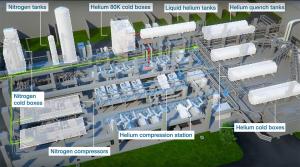How does the ITER cryoplant work?
Cold is essential to ITER—10,000 tonnes of superconducting magnets, the thermal shield that surrounds the machine, the cryopumps that achieve the high vacuum inside the vacuum vessel ... all need to be brought down to extremely low temperatures (between minus 193 °C and minus 269 °C).
In order to deliver the cooling fluids to the machine, a large cooling plant has been built at ITER that ranks as the most powerful single-platform cryoplant in the world.
Designed and manufactured by Air Liquide, the ITER cryoplant includes three helium refrigeration units, two nitrogen refrigeration units and 1.6 kilometres of cryogenic lines connecting the plant to the Tokamak Building. Installation activities are underway now.
The complex workings of the ITER cryoplant are explained in this video, produced by Air Liquide.


